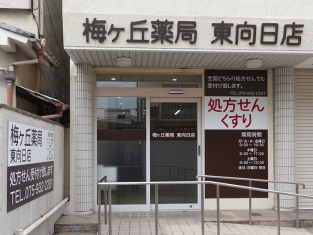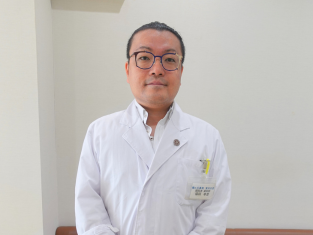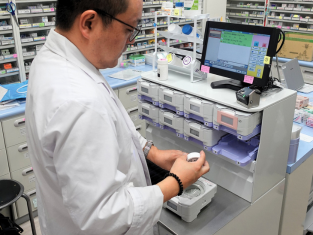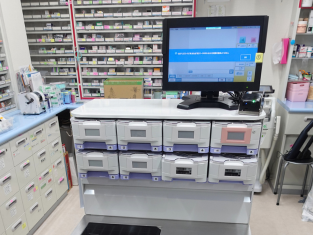- TOP
- Product
- User Reports
- Umegaoka Pharmacy Higashimukō Store
Umegaoka Pharmacy Higashimukō Store
Representative Yukihiko Fukuda

Automate the multiple tablet packaging ~Securing time for patient follow-up~
Compact Tablet Packaging Machine MINDOSE-8
Automate the multiple tablet packaging ~Securing time for patient follow-up~
Aiming to improve the efficiency and quality of pharmacy operations
In recent years, with the aging of the population, the need for multi-dose dispensing has been gradually increasing. In response to this trend, many pharmacies have introduced tablet packaging machines to improve the efficiency of their dispensing operations. THERAPEUTIC PHARMACY (represented by Mr. Yukihiko Fukuda), which operates three pharmacies in the southern part of Kyoto Prefecture, is one such pharmacy. Its Umegaoka Pharmacy Higashi-Mukō store is also among those that have adopted this approach.Last winter, the pharmacy introduced Yuyama’s compact tablet packaging machine, the “MINDOSE-8,” which has reduced the manpower previously required for tasks such as tablet packaging, allowing pharmacists to spend more time on patient-facing duties and also helping to reduce dispensing errors.
The pharmacy is located in a residential area about a 5-minute walk from Hankyu Railway Higashi-Mukō Station.With the increase in the number of prescriptions filled, the demand for multi-dose dispensing has also grown so that automated the manual filling process. Mr. Fukuda, the founder of the pharmacy and a pharmacist, “By introducing automation, we have been able to increase the time we spend communicating with patients.We aim to fulfill the core value of pharmacists by enhancing communication with patients and contributing to the optimization of medication therapy.”
The Higashi-Mukō store, which opened in 2016, fills approximately 600 prescriptions per month, primarily for nearby internal medicine, gastroenterology, and respiratory clinics.Initially, many patients were unfamiliar with the concept of outpatient prescriptions, which had been changed from inpatient prescriptions at nearby clinics, and some were reluctant to pick up their medications at the pharmacy.
However, by listening to the experiences of people from various industries and building on that knowledge, the pharmacy continued its operations based on the corporate philosophy of “education,” “safety,” and “gratitude.” As a result, it has now gained the trust of patients to the point where they consult the pharmacy about issues they cannot directly discuss with their doctors, such as concerns about medications.
Over time, the pharmacy’s reputation grew through word of mouth, and it began filling prescriptions for patients from clinics outside the immediate vicinity.
At the very first phase when they open this pharmacy, it was located in a residential area near the station, aiming to be a pharmacy that people could visit on their way to work or school. However, now, most of the approximately 800 prescriptions/ month are from local residents, and Mr.Fukuda says, “It was different from what we had expected, but it is very gratifying to hear local people say, “It’s good that there is such pharmacy here”.



Safety design for GS1 code matching
At this store, along with an increase in the number of prescriptions, the demand for multi-dose packaging has rapidly increased due to the large number of elderly residents in the area.Until now, we had been filling manually and packaging individual sachet, but in order to improve operational efficiency, we decided to automate the process and introduced “Mindose 8” from Yuyama.This machine is a compact tablet packaging machine equipped with eight “Universal Cassettes” (UC) that adjust the dispensing openings according to the shape of the tablets, enabling it to handle various types of medications. With dimensions of 60 cm in width, 56.5 cm in depth, and 123 cm in height, so it can be installed anywhere.
The store already had a powder dispensing machine equipped with a Yuyama hand-sowing adapter, and although they considered adding UC as an option, decided to introduce MINDOSE-8 due to space constraints.Mr. Fukuda said, “My first impression of MINDOSE-8 was that it was very small.Considering the installation costs, the store felt that introducing Mindose Eight as a new system would be more advantageous than adding the UC option to the existing powder dispensing machine.
The specific process of packaging “MINDOSE-8” is as follows: First, when the device receives prescription data from the pharmacy information system, the name of the drug, the number of tablets, and the patient’s name are displayed on the electronic paper attached to the front of the UC. The applicable drug is then loaded into the UC according to that information, but before loading, the GS1 code of the drug must be verified by the reader of the packaging machine. The lock on the cassette only releases when the prescription data and medication match, ensuring a safe design that prevents the accidental dispensing of the wrong medication. Once the lock is released, the UC is removed, and the required number of tablets for packaging are filled. When the UC is reinserted into the machine, the packaging process begins.
With this device, up to three prescriptions can be assigned to the UC, allowing for efficient batch processing of medication filling.
In addition, it offers a wide range of optional features, including a half-tablet UC that can dispense tablets cut into half tablets, a six-color LED guide display for manual dispensing, and an automatic four-color pen liner. Mr. Fukuda emphasizes that one of the major benefits of introducing this device is the reduction in dispensing errors. By using the safety-designed UC to automate the process of packaging tablets, human errors have been reduced. Even with manual filling process, human errors are rare if the operator remains focused, but interruptions such as phone calls or patient consultations can distract the operator, leading to errors. Since the machine manages the process, such as tracking which medications have been dispensed, it is easier to resume work, which is a benefit of automation.
Mr. Fukuda also mentioned that “more time can be spent consulting with patients, reviewing medication histories, and following up with patients” are added as another benefit. Previously, staff had to be constantly present for manual filling, but automation has freed up time for interpersonal tasks. Since the facility operates with two existing packaging machines, they are used depending on the prescription, and also serve as a backup in case one machine malfunctions. Six months have passed since the equipment was introduced, and Mr. Fukuda evaluates it as “honestly, it was a good decision to introduce it.”
(From the pharmaceutical reports)
Information as of July 2025

